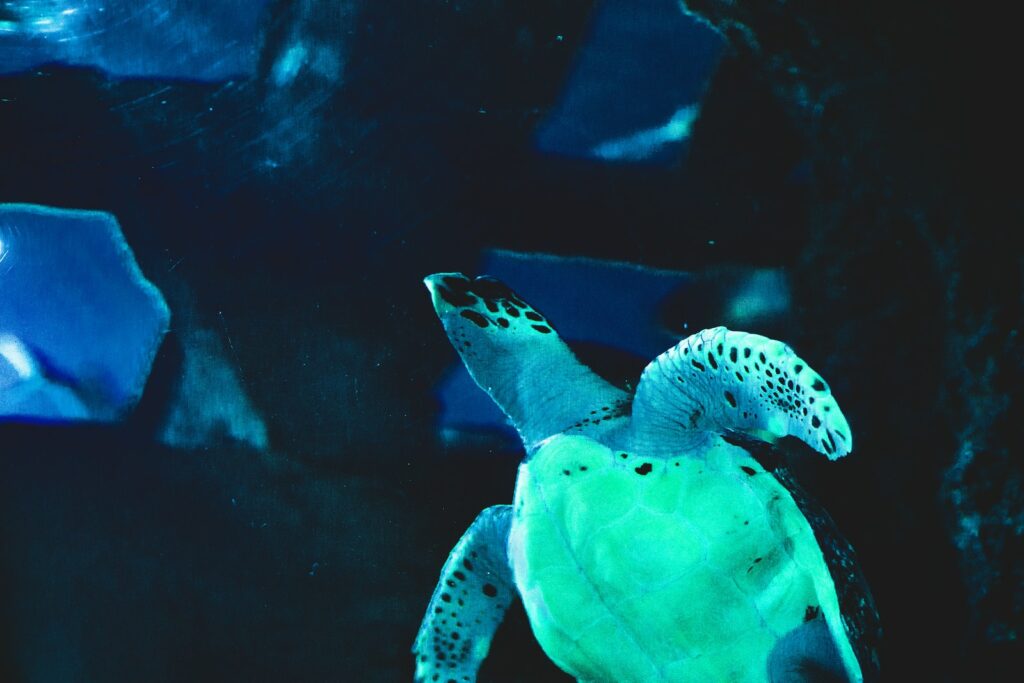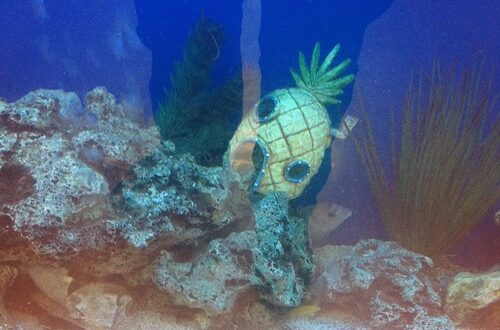Keeping pet aquatic turtles like red-eared sliders, cooters, and various terrapins species can be immensely enjoyable and rewarding. But turtles aren’t necessarily the most active or engaging pets to simply observe in an aquarium.
Adding compatible fish species to a turtle habitat can provide visual interest through their schooling behaviors and activity, while also conferring other benefits for both the fish and turtle tankmates. With proper planning and species selection, certain hardy, fast fish can make excellent companions in a turtle aquarium.
Benefits of Keeping Fish with Turtles
Aside from simply being more aesthetically pleasing to watch multiple species interacting, incorporating select fish into a turtle tank offers some key advantages:
Reduce Turtle Aggression and Territorialism
Turtles occasionally become aggressive, defensive, or exhibit territorial behaviors when housed alone in a tank over extended periods. The presence of active fish schools provides a healthy diversion for the turtle and diffuses aggressive tendencies directed at owners during handling or feeding.
Provide Environmental Enrichment
Schools of colorful fish swimming through the upper levels of the tank provide engaging enrichment for a curious turtle. Watching and even slowly stalking fish keeps the turtle’s mind active and alleviates boredom or monotony from lack of activity, especially common in solo turtle tanks. This mental stimulation is quite healthy for turtle pets.
Make Full Use of Aquarium Space
While turtles utilize the lower and middle areas of the tank, fish are able to occupy upper levels that the turtle cannot reach on its own. Adding compatible fish allows for fuller use of the tank’s water volume across vertical swimming zones. More species harmoniously coexisting creates a dynamic, productive aquatic ecosystem.

Choosing Appropriate Fish Species for a Turtle Tank
While the concept of adding fish tankmates to a turtle habitat sounds promising, selecting fish species suited for cohabitation is critical to success. Avoid throwing any random fish in with your turtle and hoping for the best. Carefully consider these factors when choosing fish:
Match Fish to the Turtle’s Temperature Requirements
Freshwater aquatic turtles thrive in water from approximately 75-80 degrees Fahrenheit. Tropical or subtropical fish species that share similar temperature preferences are the safest options for long term housing with a turtle. Coldwater fish like goldfish would become lethargic and prone to disease at those warmer temperatures.
Avoid Fish Vulnerable to Turtle Aggression
Unfortunately most small, brightly colored fish often marketed as turtle tankmates, such as guppies, tetras, or danios, risk becoming targets for even well-fed juvenile turtles. Their size and flashy appearance can trigger the turtle’s prey drive. Larger, faster swimming fish are less likely to suffer harassment or attacks.
Select Appropriate Fish Sizes
Fish tankmates should be no smaller than 1.5 to 2 inches fully grown to be large enough that small juvenile turtles cannot physically consume them. However they also should max out at sizes under 4 inches to avoid competing with the adult turtle for food or habitat space when it eventually grows larger.
Consider Schooling Fish vs. Solitary Species
Schooling fish like tetras, danios, mollies, platies, etc do best housed in larger groups of at least 6-10 individuals, as they feel safest and exhibit natural behaviors in these group sizes. On the other hand, solitary fish like male bettas may become stressed or fearful housed with a predatory turtle, even if their flowing fins are not targeted.
Best Fish Species for Cohabitating with Turtles
Taking those factors into account, below are some prime candidates that typically do well sharing tank space with an appropriately sized aquatic turtle:

Platies
One of the most commonly recommended fish, platies are peaceful, easy to care for, and available in a myriad of colors. They reach a maximum length around 2-3 inches. Keep in groups of 4-6 fish to see natural schooling behavior. Both males and females can peacefully coexist.
Mollies
These active, personable fish thrive in hard alkaline water – the same conditions turtle tanks are set up for. Mollies come in several varieties ranging in size from under 2 inches for dwarf mollies up to 3+ inches for sailfin and other large morphs. Keep them in groups of 3-5 or more.

Swordtails
Swordtails are another vivacious livebearer fish, noted for their energetic schooling and the elongated sword-like extensions on the tails of mature males. Multiple color varieties exist, with fish growing as large as 3-4 inches at maturity. They should be kept in groups of at least 5-7 fish.
Larger Tetra Species
Smaller neon tetras and cardinal tetras are too diminutive for turtle tanks, but some larger varieties like Congo tetras, emperor tetras, and Buenos Aires tetras that reach lengths of 2 inches can work well. They need schools of at least 6-8 of their own kind.
Danios
Though tiny species like zebra danios are unsuitable, larger danios that grow to around 2 inches like giant danios and longfin danios can make active turtle tank additions. Their constant darting and schooling tends to fascinate observing turtles. Keep in groups of 8-10.

Corydoras Catfish
Also called cory cats, these docile bottom dwellers are armored with plates and spines to protect from turtle aggression. At 2-3 inches in size, they helpfully scavenge debris and food bits while remaining too large for small turtles to successfully eat. Have at least 3-5.
Plecostomus
Often called “plecos”, these sucking armored catfish thrive in turtle tanks eating excess algae. Growing over a foot long, an adult pleco is safe from turtle harassment and too big for the turtle to consume. Just one pleco is sufficient for most tanks.
Setting Up the Turtle and Fish Habitat
To help fish cohorts thrive alongside a turtle, provide an ideal habitat with:
Adequate Tank Size
Realistically, the tank should be at least 40 gallons or more in size to comfortably house one small aquatic turtle plus a school of around 8-10 smaller fish. Bigger is always better, with 55+ gallon tanks preferred.
Robust Filtration
Strong water flow and filtration are vital in turtle-fish setups, due to the high bio-load created. Invest in a heavy duty canister filter rated for at least twice the normal capacity needed for the tank size. Undertank and sump filters also work well.

Plants and Decor for Shelter
Provide ample hiding spots for fish to retreat from an inquisitive turtle. Live aquatic plants like anubias or java fern are ideal, but silk plants also suffice. Rock overhangs, bogwood, and decorations create Visual barriers.
Slow Acclimation When Introducing New Fish
To avoid shock, gradually acclimate new fish over an hour or more using a quarantine container or drip method. Also turn off tank lighting to reduce stress and isolate the turtle at first so fish can safely explore
Keeping the Peace between Fish and Turtle Tankmates
Acclimating fish and providing them adequate shelter are just the first steps. Maintaining a harmonious environment long-term requires added vigilance:
Observe Interactions and Watch for Signs of Aggression
Monitor turtle-fish dynamics closely, especially at first. Remove any fish that become frequent turtle targets or show signs of stress like clamped fins from the turtle’s presence.
Provide Ample Hideouts and Visual Barriers for Fish
Ensure fish constantly have access to dense thickets of plants, rock overhangs, driftwood, or decorations to retreat and break the turtle’s line of sight if chased excessively.
Feed the Turtle a Nutritious Staple Diet
Provide a calcium-rich turtle pellet or stick as the dietary staple so the turtle is less likely to view small fish as food. Feed fish on the opposite end of the tank from the turtle’s feeding area.
Maintain Proper Water Quality Parameters
Test water conditions frequently and perform partial water changes as needed to prevent ammonia, nitrites, nitrates, and pH from reaching harmful levels that could stress fish or turtle alike.
Conclusion
While risky in some cases, housing sturdy, fast-moving fish species that are too large for tiny juvenile turtles to physically consume allows for safe cohabitation in many scenarios. Providing an expansive, enriching habitat and tending to both pets’ health and wellbeing helps foster a flourishing underwater community where turtle and fish can observe one another’s behaviors for their mutual enjoyment. With proper research and preparation for potential challenges, the experience of watching compatible turtle and fish interact can bring new vibrance and activity to your home aquarium.
What fish get along best with turtles in aquariums?
Some top choices are mollies, platies, swordtails, large tetras and barbs, giant danios, bronze cory cats, bristlenose plecos, and other 2-4 inch sized schooling fish or armored bottom feeders. Avoid small species prone to nipping or being eaten.
Can goldfish or betta fish live with a turtle?
Goldfish are not ideal turtle tankmates – they thrive in cooler water than turtles, have risk of diseases, and their long flowing fins may be nipped. Bettas may become stressed or have fins targeted. Select hardier community fish optimized for turtle habitats.
Will a turtle actually eat fish I add to its tank?
Most aquatic turtles will opportunistically eat small fish they can swallow if housed together and may stalk and attack fish. However a properly fed, non-aggressive adult turtle over 5 inches in size should not be able to consume the recommended larger, faster fish tankmates.
Should I add fish before or after getting a new turtle?
It’s generally best to fully set up and stabilize the tank environment for the turtle first, allowing 2-6 weeks for optimal water quality before introducing hardy fish species. Adding fish too soon could expose them to unsafe new tank syndrome conditions as the tank establishes.
What is the proper way to introduce fish to an established turtle tank?
Use a quarantine container or dripping acclimation method over 1-2 hours. Turn off tank lights and isolate the turtle during the process. Observe fish closely for signs of stress the first few days and promptly remove injured or dying fish.

